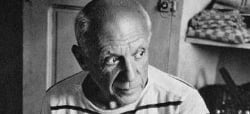The Surrealist’s Stew
Discover the humble Spanish garlic soup that nourished Picasso’s soul and inspired his art — a recipe rich in memory, flavor, and poetic simplicity. A Soup Worthy of a Museum: Garlic was one of Picasso’s obsessions. He carried it with him everywhere, attributing it with “purifying” and energizing powers. During intense painting periods, he even ate it raw — rubbed on bread. Picasso and Cubist Cuisine. He often rejected elaborate or overly aesthetic dishes. He used to say: “A dish must be like a canvas before color: simple, true, pure.” No decoration on his garlic soup. Just substance. His personal ritual. After eating, he liked to sit in silence. Then, slowly, he’d rise, take his notebook, and draw. Some sketches in his private archives are stained with oil. Art and soup: inseparable. Because an artist’s kitchen is never banal.
MASTERCHEFS & MASTERPIECES
Charlotte Madeleine CASTELLI
6/14/20252 min read


🥄🎨 “Sopa de Ajo”: The Garlic Soup That Enchanted Picasso
A journey through flavors, painting, and the poetry of simplicity
“Everything you can imagine is real.”
That’s what Picasso used to say — and who knows, maybe as the steam rose from his beloved garlic soup, he imagined his women with double eyes, the bulls with broken horns, and a burning Spain, both inside and beyond his canvases.
Sopa de Ajo is not just a recipe. It’s a poetic statement. It’s the way Picasso the man — before the genius — returned to his roots. Back to the red earth of Andalusia, to the gestures of women cooking with their hands and hearts, to the scents of white houses under the Malaga sun.
A humble, peasant soup, yet full of meaning: strong like cubist painting, essential like a charcoal line, warm like an embrace in winter.
📖 Picasso’s Authentic Garlic Soup Recipe
Reconstructed from biographical sources and family stories
🧄 Ingredients for 2:
1 liter of water or light broth (vegetable or meat-based)
4 garlic cloves (preferably pink or purple – more delicate)
3 tbsp extra virgin olive oil
1 tsp smoked sweet paprika (pimentón de la Vera)
2 slices of stale bread, cubed
2 very fresh eggs
Fine salt, to taste
Freshly ground black pepper, as desired
(Optional) A splash of dry sherry or white wine
👩🍳 Professional (and slightly poetic) Method
Warm up your memory.
In a wide, shallow pot — ideally terracotta — pour in the oil and gently heat it.
Add whole garlic cloves or crush them slightly with the side of a knife. Let them turn golden, not brown. They must release their soul.
Color time.
Stir in the smoked paprika with a wooden spoon. The aroma will transport you to a Spanish market, between jamón and olives.
Add the bread.
Let the bread cubes soak in the oil like sponges of the past. Toast them for a few minutes until crisp.
Deglaze with poetry.
(Optional but recommended): a splash of dry sherry or white wine. Let it evaporate.
Pour in the hot broth.
Or water, for the humbler version. Bring to a boil, add salt to taste, and simmer gently for about 10 minutes, until the bread partially dissolves and the texture becomes that of a memory.
The final touch: the egg, symbol of creation.
With the heat off, crack the eggs directly into the soup, one at a time. Do not stir. Let them cook slowly, like a lullaby in liquid form.
Serve hot, with a touch of black pepper and, if you wish, a sprinkle of fresh parsley or coriander.
Next time you slice garlic, think of Picasso.
His table full of friends, the scent of real things, dishes that tell stories better than words. Because even a genius needs, from time to time, a good soup.
© 2025 Charlotte Madeleine Castelli. All rights reserved.
